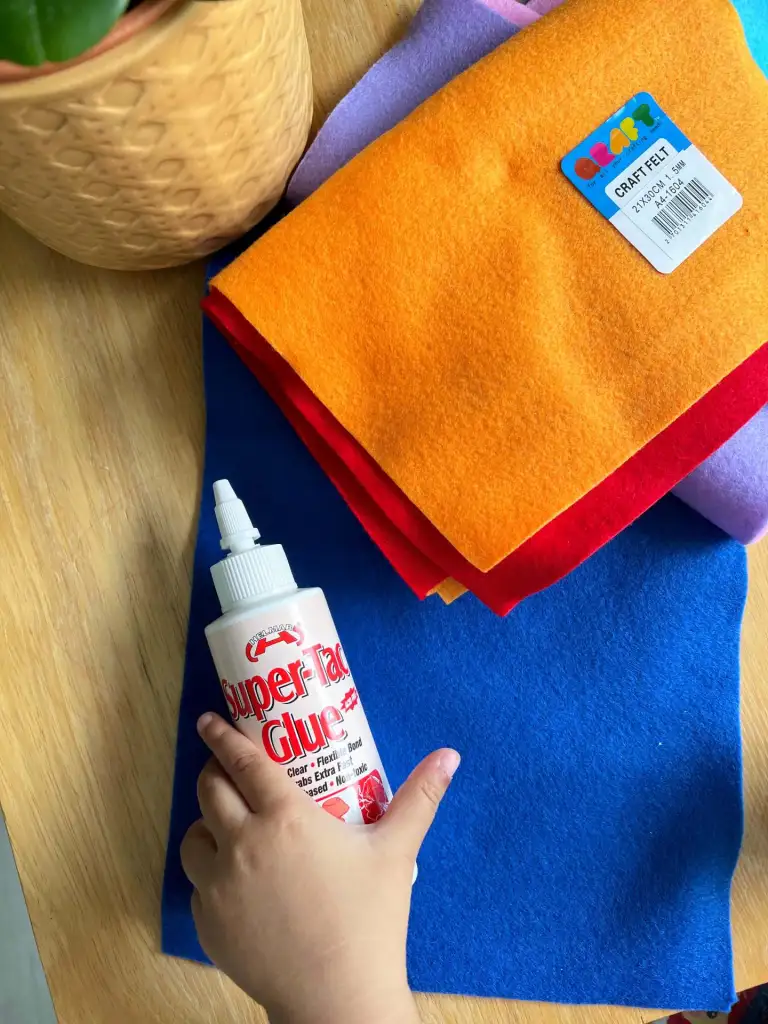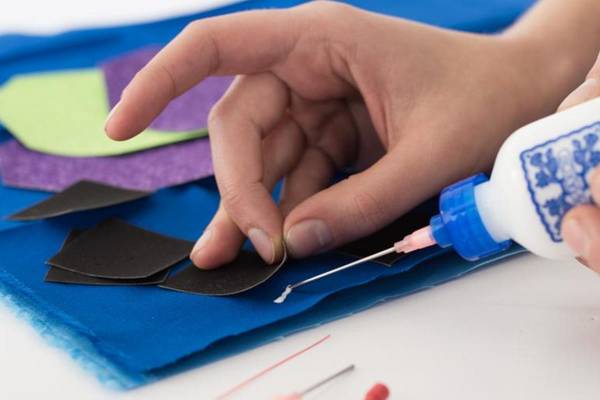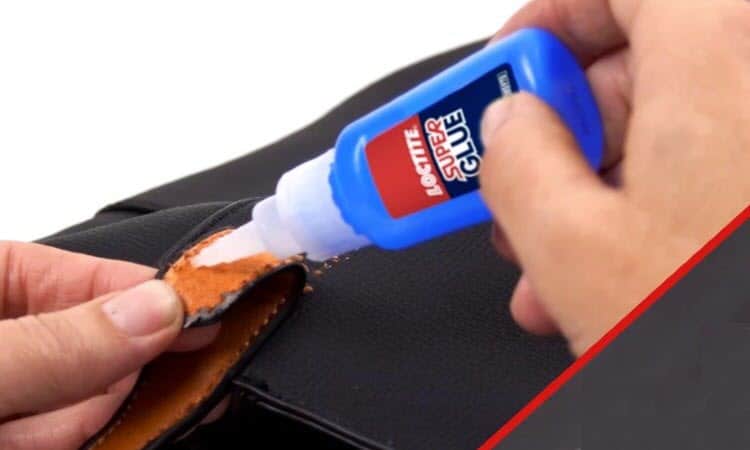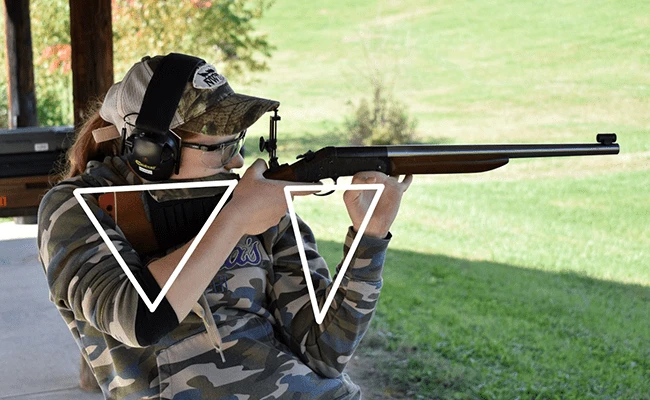Yes, superglue can work on fabric, but its effectiveness may vary depending on the type of fabric and the intended use.
So, you’ve found yourself in a bit of a sticky situation with fabric and wondering if super glue might be the magical solution.
We’ve all been there – whether it’s a torn favorite pair of jeans or a little DIY project gone awry. The world of adhesives can be a bit confusing, but fear not! We’re about to explore whether super glue is the fabric superhero you’ve been hoping for.
So, buckle up, and let’s unravel the mysteries of bonding textiles with the mighty power of super glue!
Understanding Super Glue

Explanation of Super Glue Composition:
You might know super glue, also called cyanoacrylate adhesive, is a fast-sticking glue. It’s famous for making really strong bonds in no time.
The composition of super glue is relatively simple, consisting mainly of cyanoacrylate monomers. Here’s a breakdown of its composition:
Cyanoacrylate Monomers:
The main active ingredient in super glue is cyanoacrylate. These fast-reacting molecules polymerize (form long chains) when they come into contact with moisture, particularly the water vapor in the air.
Polymerization:
Cyanoacrylate monomers come into contact with a surface and undergo a rapid polymerization reaction. This reaction is triggered by the presence of moisture, causing the monomers to link together and form strong, durable bonds.
Inhibitors and Stabilizers:
Super glue formulations often include inhibitors and stabilizers to control the polymerization rate and extend the product’s shelf life. These additives help prevent premature hardening of the glue.
How Super Glue Works on Various Surfaces:
Super glue is known for its versatility and ability to bond various materials. Its effectiveness on different surfaces is attributed to the mechanism of polymerization triggered by moisture. Here’s how super glue works on various surfaces:
Porosity and Absorption:
Super glue is highly effective on porous surfaces such as wood, paper, fabric, and certain plastics. Porous materials absorb the glue, providing a larger surface area for bonding.
Smooth and Non-Porous Surfaces:
While super glue can work on smooth and non-porous surfaces like glass, metal, and ceramics, it may require a slightly different approach.
Applying a small amount of water to one of the surfaces or using a primer designed for cyanoacrylate adhesives can enhance bonding on non-porous materials.
Preparation:
To get the best results, make sure the surfaces you’re sticking together are clean and dry. Any contaminants or moisture can affect the bonding process. Sanding or roughening the surfaces can also enhance the bond, especially on smooth materials.
Temperature and Humidity:
The speed of the bonding reaction is influenced by temperature and humidity. Warmer temperatures and higher humidity levels generally accelerate the curing process, resulting in faster bond formation.
Flexibility and Strength:
Super glue creates bonds that are rigid and strong. While this is advantageous for many applications, it may not be suitable for situations requiring flexibility.
In such cases, flexible formulations of cyanoacrylate adhesives or other types of adhesives may be more appropriate.
Knowing how super glue is made and how it works helps you choose and use it wisely for sticking things together.
Types of Fabric-Compatible Super Glues
Overview of Super Glue Options Suitable for Fabric:
When it comes to bonding fabric, not all super glues are created equal. Some are specifically formulated to work well with various types of fabrics, providing strong and durable bonds without causing damage.
Here’s an overview of super glue options suitable for fabric:
Fabric Glue:
Some super glues are labeled as “fabric glue” or “fabric-friendly.” These formulations are designed to bond fabric without compromising its integrity. They often dry clear and remain flexible, allowing the bonded fabric to maintain its natural texture and movement.
Flexible Super Glues:
Certain super glues are formulated to create flexible bonds, making them ideal for fabrics requiring some stretch or movement. These glues can withstand bending and flexing without becoming brittle, ensuring that the bond remains intact even in dynamic conditions.
Waterproof Formulations:
Waterproof or water-resistant fabric glues ensure that the bond remains strong even when the fabric is exposed to water.
Quick-Drying Varieties:
Quick-drying super glues are beneficial when working with fabrics that need an instant bond. These glues set rapidly, allowing for efficient and time-saving fabric repairs or projects.
Clear and Invisible Bonds:
Some fabric-compatible super glues dry clear, leaving behind invisible bonds. This feature is useful When working with light or transparent fabrics. It makes the glue less visible, which is very helpful.
Considerations for Different Fabric Types:
If you’re putting super glue on fabric, it’s important to think about the fabric’s unique qualities. This helps make sure the bond is strong and lasts. Here are some considerations for different fabric types:
Natural Fabrics (Cotton, Linen, Wool):
Natural fabrics are generally more porous and may absorb glue more readily. Fabric glues that are flexible, waterproof, and suitable for porous materials work well with cotton, linen, wool, and similar fabrics.
Synthetic Fabrics (Polyester, Nylon, Spandex):
Synthetic fabrics often have smoother surfaces, requiring a fabric glue that adheres well to non-porous materials. If you’re dealing with stretchy synthetic fabrics like polyester, nylon, or spandex, using flexible super glues that can handle stretching is a good idea.
Delicate or Sheer Fabrics:
Delicate or sheer fabrics require extra care to avoid visible stains or damage. Choosing a clear, fabric-friendly super glue that dries quickly and remains flexible ensures a discreet and reliable bond without compromising the fabric’s appearance.
Outdoor Fabrics:
Fabrics used for outdoor applications, such as awnings or outdoor furniture covers, should be bonded with waterproof super glues to withstand exposure to rain and other environmental factors.
Washable Fabrics:
Fabrics that may require washing, such as clothing or household linens, benefit from fabric glues that are labeled as washable. These glues maintain their strength and adhesion even after being laundered.
Additionally, considering the fabric’s intended use and care requirements will help determine the most suitable fabric-compatible super glue for the job.
Steps for Using Super Glue on Fabric
Preparing the Fabric Surface:
Clean the Fabric:
To begin, make sure the fabric is free from dirt, dust, or any residues. If needed, use a mild detergent or fabric cleaner. Cleaning helps promote better adhesion and ensures that contaminants do not compromise the bond.
Test in an Inconspicuous Area:
Before applying super glue to a visible area, test it in a small, inconspicuous spot on the fabric. This ensures compatibility and allows you to observe how the fabric reacts to the glue.
Roughen Smooth Surfaces (if needed):
If you are working with a smooth or non-porous fabric, lightly roughen the bonding area with fine sandpaper. This helps create a surface that the glue can better adhere to.
Ensure Dryness:
Confirm that the fabric is completely dry before applying super glue. Excess moisture can interfere with the bonding process and compromise the strength of the bond.
Applying Super Glue Effectively:
Choose the Right Super Glue:
Select a super glue specifically designed for fabric or one that is flexible and suitable for the type of fabric you are working with. Consider factors such as flexibility, drying time, and transparency.
Use in Moderation:
Apply the super glue sparingly to avoid excess seeping through the fabric or creating a visible residue. A small amount is often sufficient for a strong bond.
Apply Evenly:
Spread the super glue evenly over the bonding area to ensure uniform adhesion. Use a thin layer to prevent excessive stiffness in the fabric.
Work Quickly:
Super glue typically sets quickly, so it works efficiently. Once applied, press the fabric pieces together promptly to initiate the bonding process. Check the manufacturer’s instructions for the glue’s specific drying time.
C. Ensuring a Secure Bond:
Apply Pressure:
Press the bonded fabric pieces together firmly. Applying even pressure helps the super glue spread and create a strong bond. Use your fingers or a flat, clean tool to apply pressure evenly.
Allow Adequate Drying Time:
Give the super glue sufficient time to dry and set. While some glues dry in seconds, others may take a few minutes. Avoid disturbing the bonded area during this time to ensure a secure and stable bond.
Check for Bond Strength:
Once the glue has dried, gently tug or pull on the bonded fabric to ensure the strength of the bond. If it feels secure, you have successfully glued the fabric. If not, reapply the glue and repeat the process.
Tips and Tricks
Best Practices for Using Super Glue on Fabric:
Read Instructions:
Always read and follow the instructions provided by the super glue manufacturer. Different formulations may have specific recommendations regarding application, drying time, and safety precautions.
Choose the Right Type:
Select a super glue designed for fabric or labeled as flexible and suitable for the specific type of fabric you are working with. Consider factors such as flexibility, transparency, and drying time.
Test in a Small Area:
Before using super glue on a noticeable part of the fabric, do a small test in a hidden spot. This helps check if the glue works well with the fabric and how the fabric reacts to it.
Prepare the Surface:
Clean the fabric thoroughly to get rid of any dirt or contaminants. If the fabric is smooth or non-porous, think about using fine sandpaper to roughen the surface. This can help improve how well the adhesive sticks.
Apply Sparingly:
Use a small amount of super glue to avoid excess seeping through the fabric or creating a visible residue. A thin, even layer is generally sufficient for a strong bond.
Work Quickly and Precisely:
Super glue sets quickly, so work efficiently. Apply the glue evenly, press the fabric pieces together promptly, and avoid disturbing the bonded area until the glue has fully dried.
Use Tools for Precision:
When applying super glue, consider using tools such as a small brush or toothpick for precision.
Apply Pressure:
Press the bonded fabric pieces together firmly to ensure a strong bond. Use your fingers or a flat, clean tool to apply even pressure across the glued area.
Common Mistakes to Avoid:
Excessive Glue Application:
Applying too much super glue can lead to visible residues, stiffness in the fabric, or seepage through porous materials. Use a minimal amount for the best results.
Ignoring Compatibility:
Not all super glues are suitable for every type of fabric. Using an incompatible glue may result in poor adhesion or damage to the fabric. Choose a glue that matches the fabric type.
Incomplete Surface Preparation:
Neglecting to adequately clean or prepare the fabric surface can hinder the bonding process. Ensure the fabric is clean, dry, and, if necessary, roughened for better adhesion.
Disturbing the Bonded Area Too Soon:
Super glue requires some time to set and cure. Avoid touching or stressing the bonded area until the glue has fully dried to prevent weakening the bond.
Not Testing in Advance:
Skipping the step of testing in an inconspicuous area may lead to unwanted reactions between the fabric and the glue. Always conduct a small test to ensure compatibility.
Alternative Methods and Precautions:
Fabric Adhesives:
Consider using fabric adhesives or hemming tape, especially for applications where flexibility is crucial. These alternatives are designed specifically for fabric bonding and may offer different properties than traditional super glue.
Sewing as an Alternative:
In cases where flexibility and durability are essential, sewing may be a more suitable option. Fabric glues are ideal for quick fixes, but sewing provides a long-lasting and flexible solution.
Ventilation:
When you’re using super glue, make sure to work in a place with good ventilation. This helps the air circulate well and reduces the chance of breathing in fumes.
Safety Precautions:
To shield your skin from accidental contact with super glue, wear suitable personal protective equipment, like gloves. If skin contact occurs, follow the recommended steps for removal provided by the manufacturer.
Success Stories and Testimonials

Real-Life Examples of Successful Fabric Bonding with Super Glue:
Emergency Clothing Repair:
Many individuals have successfully used super glue to mend torn seams or hems on clothing, especially when faced with unexpected wardrobe malfunctions. The quick-drying nature of super glue allows for on-the-spot repairs.
Outdoor Gear Fix:
Outdoor enthusiasts have shared stories of using super glue to repair fabric-based outdoor gear, such as tents, backpacks, and sleeping bags. The flexibility and durability of certain fabric-compatible super glues make them well-suited for these applications.
Costume and DIY Projects:
Crafters and DIY enthusiasts often use super glue for fabric bonding in costume-making or various creative projects. The ability of super glue to create strong bonds quickly is valued in time-sensitive crafting situations.
Upholstery Repairs:
Homeowners have successfully repaired small tears or loose seams in upholstery using fabric-compatible super glue.
Quick Shoe Fixes:
Super glue has been employed to fix detached soles or tears in shoe fabric. The fast bonding properties of super glue make it a handy tool for makeshift shoe repairs when a quick fix is needed.
User Testimonials and Experiences:
Jane S., DIY Enthusiast:
“I recently used fabric-compatible super glue to repair a tear in my favorite pair of jeans. It held up remarkably well, and the bond remained strong even after multiple washes. It’s become my go-to solution for quick fabric fixes.”
Mike R., Outdoor Adventurer:
“During a camping trip, my tent suffered a small tear. I patched it up using a flexible, super glue designed for fabric. The repair held up against wind and rain throughout the rest of the trip. Super glue saved the day!”
Sarah L., Costume Designer:
“In the world of costume design, quick fixes are often needed. I’ve used fabric-friendly super glue on numerous occasions for attaching embellishments and securing seams. It’s a lifesaver when time is of the essence.”
Tom M., Homeowner:
“Our couch had a small tear in the upholstery, and I decided to try fabric glue as a temporary fix. To my surprise, the bond held up so well that we haven’t felt the need for a professional repair. It’s a cost-effective solution for minor upholstery issues.”
Lisa K., Fashion Blogger:
“I accidentally ripped a delicate silk blouse and hesitated to sew it. I tried a clear fabric glue, and the result was amazing. The tear is barely noticeable, and the fabric maintains its natural drape. Super glue saved one of my favorite pieces!”
These success stories and testimonials highlight the versatility and effectiveness of fabric-compatible super glue in various real-life situations.
While it’s important to consider the specific requirements of each project, these positive experiences showcase the value of super glue in fabric bonding applications.
Troubleshooting
Addressing Common Issues When Using Super Glue on Fabric:
Visible Residue:
Issue: Excessive application of super glue may result in visible residue on the fabric.
Solution: If residue is visible, gently scrape it off using a razor blade or the edge of a plastic card once the glue has fully dried. Use a minimal amount of glue for future applications to avoid this issue.
Stiffness in Fabric:
Issue: Overuse of super glue may cause the fabric to become stiff and lose its natural flexibility.
Solution: When bonding fabrics that require flexibility, choose a flexible or fabric-compatible super glue. Applying a thin layer evenly across the bonding area can also help minimize stiffness.
Incomplete Bond:
Issue: If the bond feels weak or incomplete after drying, it may be due to inadequate application or insufficient pressure during bonding.
Solution: Reapply the super glue, ensuring even coverage, and press the fabric pieces together with firm and even pressure. Allow the glue to fully dry without disturbing the bond.
Difficulty Bonding Smooth Fabrics:
Issue: Super glue may not adhere well to smooth or non-porous fabrics.
Solution: For smooth fabrics, lightly roughen the bonding area with fine sandpaper to improve adhesion. Additionally, consider using a primer designed for cyanoacrylate adhesives on non-porous surfaces.
Bonding Issues in High-Humidity Conditions:
Issue: High humidity can affect the speed of the bonding process.
Solution: Work in a well-ventilated area and ensure that the fabric is dry before applying super glue. Consider using a dehumidifier if necessary.
How to Undo or Fix Mistakes:
Removing Excess Glue:
If you put on too much super glue by mistake, use acetone or acetone-based nail polish remover to dissolve and wipe away the excess.
Test the remover on a small, inconspicuous area first to make sure it won’t harm the fabric.
Separating Bonded Fabric:
If you need to separate bonded fabric, carefully use a razor blade or the edge of a plastic card to pry the pieces apart gently. Take caution to avoid damaging the fabric in the process.
Undoing the Bond:
Soak the connected area in warm, soapy water to completely undo the bond. This will help weaken the bond, making it easier to separate the fabric. Patience is key, as this process may take some time.
Preventive Measures:
To avoid mistakes, carefully read and follow the manufacturer’s instructions for the specific super glue you are using. Before you use the glue on a noticeable part of the fabric, test it in a hidden area to make sure it works well.
Remember that prevention is often better than correction. Taking the time to understand the fabric, choosing the right type of super glue, and working carefully can help prevent common issues associated with fabric bonding.
If mistakes occur, prompt and careful action can often resolve the situation.
FAQs
Does super glue work on fabric?
Answer: Yes, super glue can work on fabric, but choosing the right type of super glue designed for fabric bonding is important.
Can I use any super glue on fabric?
Answer: Not all super glues are suitable for fabric. Look for fabric-compatible or flexible formulations designed for various fabric types.
Will super glue bond all fabric types equally well?
Answer: Different fabric types may require specific types of super glue. It’s crucial to choose a glue that matches the characteristics of the fabric you’re working with.
How do I prepare fabric for super glue application?
Answer: Clean the fabric thoroughly, ensure it’s dry, and, if needed, lightly roughen smooth or non-porous surfaces for better adhesion.
Can super glue be used on delicate fabrics?
Answer: Yes, there are fabric-compatible super glues designed for delicate fabrics. Test the glue in a small, inconspicuous area to ensure compatibility.
Does super glue remain flexible on fabric?
Answer: Some super glues are formulated to remain flexible on fabric, providing a durable bond without compromising the fabric’s flexibility.
How long does it take for super glue to dry on fabric?
Answer: Drying times can vary, but many super glues set within seconds to a few minutes. Always follow the manufacturer’s recommendations for the specific glue you are using.
Can I wash fabric bonded with super glue?
Answer: Yes, some fabric-compatible super glues are washable. Check the product label and follow the recommended care instructions.
What should I do if I apply too much superglue?
Answer: If excess glue is visible, gently scrape it off once it’s fully dried. Use a minimal amount of glue to avoid overapplication.
How do I remove super glue from fabric?
Answer: Use acetone or nail polish remover with acetone on a clean cloth to carefully dissolve and wipe away excess super glue. Test in an inconspicuous area first.
Can super glue be used for long-lasting fabric repairs?
Answer: When used appropriately, super glue can provide strong and long-lasting fabric repairs. Ensure proper surface preparation and follow the recommended steps for application.
Conclusion
When you’re using super glue on fabric, you should be careful and follow some simple steps.
First, make sure your fabric is clean and dry. You can choose a special fabric glue that suits your needs, like one that dries clear or works on different types of fabrics.
Apply the glue carefully, not too much, and press the fabric together quickly. It’s essential to give it time to dry without touching it.
If you ever face issues like stiffness or too much glue, you can fix them using the right tools or solutions. Remember, you can always test the glue in a hidden spot before applying it to the main fabric.











